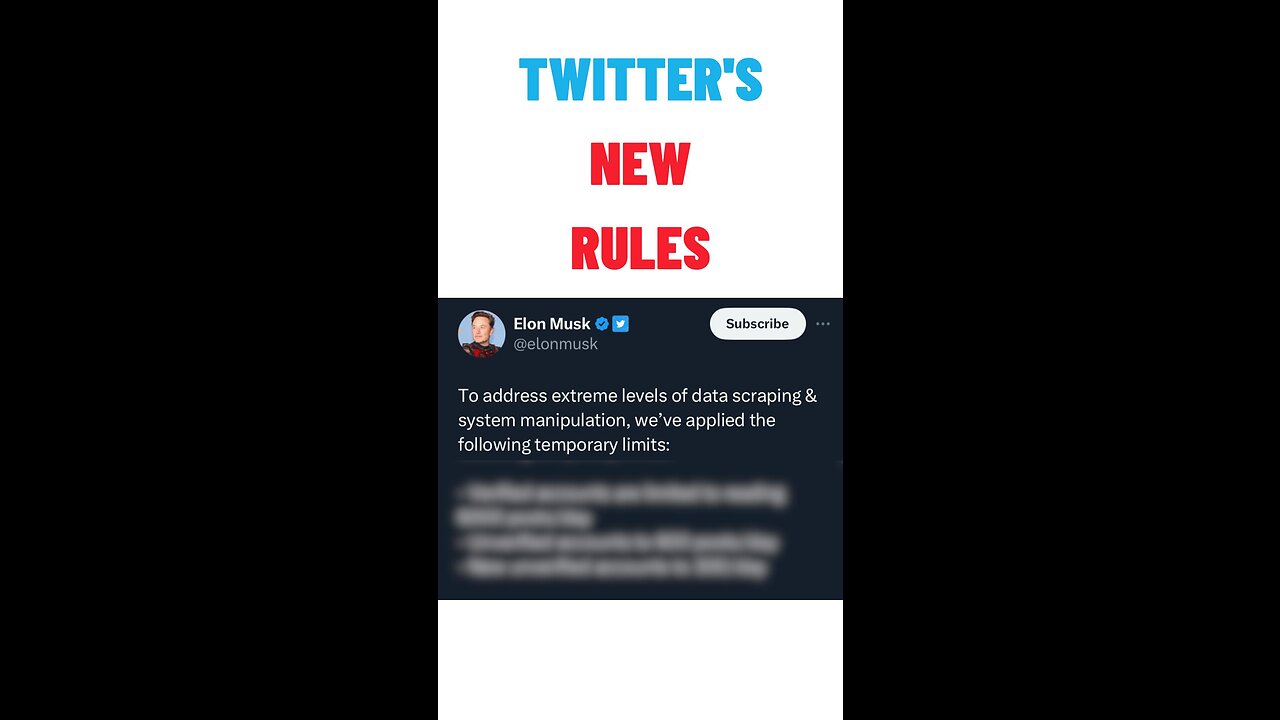Premium Only Content

Twitter's New Limits Has Everyone Furious! 🤬
In order to limit data scraping which costs Twitter money, the company has implemented some new limitations.
What is Data Scraping?
Data scraping refers to the process of extracting or "scraping" data from websites, typically using automated tools or scripts. It involves retrieving information from web pages and saving it for further analysis or use. Data scraping can be performed for various purposes, including market research, data analysis, content aggregation, or building applications that rely on up-to-date data.
When it comes to Twitter, data scraping can potentially cost the company money in a few ways:
Infrastructure costs: Data scraping puts a strain on Twitter's servers and infrastructure. When multiple automated requests are made to extract data from Twitter's platform, it increases the server load and consumes system resources. As a result, Twitter may need to allocate additional resources to handle the increased traffic, leading to higher infrastructure costs.
Bandwidth costs: Data scraping involves transferring a significant amount of data from Twitter's servers to the scraper's end. This data transfer consumes bandwidth, and Twitter incurs the associated costs for transmitting that data over its network infrastructure.
User experience and ad revenue: Data scraping can negatively impact the user experience on Twitter. Frequent scraping activities can cause slower response times, increased downtime, or other disruptions for users accessing the platform. This can lead to user dissatisfaction and potentially drive users away from the platform, resulting in reduced user engagement and potentially impacting Twitter's ad revenue.
Misuse of data: Scraped data can be used for various purposes, including building competing products or services, conducting market research, or selling the data to third parties. If unauthorized scraping activities result in the unauthorized use or distribution of Twitter's data, it can harm the company's competitive advantage, intellectual property rights, and potential revenue streams.
To mitigate these risks, Twitter has implemented various measures to prevent unauthorized data scraping, including rate limits, API access restrictions, and terms of service that prohibit scraping activities without proper authorization. Violating these terms can lead to legal consequences, including potential legal action by Twitter to protect its platform and data.
Twitter's latest rules limit Verified users to be able to read 6000 posts per day, unverified users, 600 posts per day and new unverified users can only read 300 posts per day.
Do you think these limits will be good or bad for Twitter in the long-run?
-
 4:31
4:31
CoachTY
13 hours ago $6.47 earnedCOINBASE AND DESCI !!!!
28.9K7 -
 10:02
10:02
MichaelBisping
12 hours agoBISPING: "Was FURY ROBBED?!" | Oleksandr Usyk vs Tyson Fury 2 INSTANT REACTION
2386 -
 8:08
8:08
Guns & Gadgets 2nd Amendment News
2 days ago16 States Join Forces To Sue Firearm Manufacturers Out of Business - 1st Target = GLOCK
50.9K51 -
 10:17
10:17
Dermatologist Dr. Dustin Portela
1 day ago $6.35 earnedOlay Cleansing Melts: Dermatologist's Honest Review
43.3K -
 1:02:20
1:02:20
Trumpet Daily
1 day ago $23.55 earnedObama’s Fake World Comes Crashing Down - Trumpet Daily | Dec. 20, 2024
27.3K34 -
 6:29
6:29
BIG NEM
21 hours agoCultivating God Mode: Ancient Taoist NoFap Practices
21.2K6 -
 30:53
30:53
Uncommon Sense In Current Times
1 day ago $6.01 earned"Pardon or Peril? How Biden’s Clemency Actions Could Backfire"
42.6K2 -
 40:01
40:01
CarlCrusher
19 hours agoSkinwalker Encounters in the Haunted Canyons of Magic Mesa - ep 4
40.9K2 -
 59:44
59:44
PMG
1 day ago $4.29 earned"BETRAYAL - Johnson's New Spending Bill EXPANDS COVID Plandemic Powers"
50.2K17 -
 6:48:50
6:48:50
Akademiks
17 hours agoKendrick Lamar and SZA disses Drake and BIG AK? HOLD UP! Diddy, Durk, JayZ update. Travis Hunter RUN
172K28